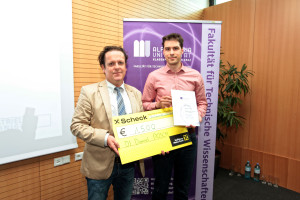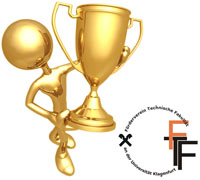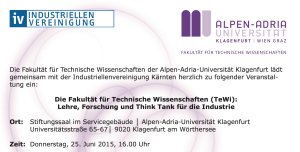
Obmann Christian Inzko (li.) übergibt den Preis an Daniel Posch (re.). Foto: Wolfgang Hoi.
… ist der Titel der besten Diplom- bzw. Magisterarbeiten aller Studien der Technischen Fakultät an der Universität Klagenfurt und wurde vom Förderverein Technische Fakultät mit EUR 1.500,– ausgezeichnet. Dem Autor und Preisträger, Herrn Dipl.-Ing. Daniel Posch, wurde der Preis im Rahmen der TEWI-Veranstaltung Lehre, Forschung und Think Tank für die Industrie übergeben und die Arbeit wird hier kurz vorgestellt:
Die stetig wachsenden Anforderungen bringen das Internet an die Grenzen der Belastbarkeit. Aus diesem Grund versuchen Wissenschaftler neue Architekturen für das Internet zu entwerfen. Eine vielversprechende Architektur ist das sogenannte Content-Centric Networking (CCN), das auch als Themengebiet dieser Masterarbeit gewählt wurde. CCN versucht die grundlegende Art der host- basierten Kommunikation des heutigen Internets durch eine inhaltsbasierte zu ersetzten. Der Grundgedanke dahinter ist, dass Internetbenutzer wissen, welche Inhalte sie benötigen, allerdings nicht wissen, wo sie diese abrufen können. Ein auf Inhalt fokussiertes Netzwerk wäre in der Lage die Effizienz, Skalierbarkeit, Mobilität und Sicherheit der digitalen Datenkommunikation zu verbessern. Diese Arbeit befasst sich im Speziellen mit der letzteren Eigenschaft und illustriert, wie das bestehende Konzept der verbindungsorientierten Sicherheit durch ein auf Inhalt orientiertes Konzept ersetzt werden kann. Besonders wird auf die dadurch entstehenden Vorteile eingegangen, die es ermöglichen verschiedenen Angriffen (z.B.: Distributed Denial of Service Attacken) besser entgegenzuwirken. Ein weiterer Fokus war die Unterstützung der Entwicklung des Sicherheitsbereiches von CCN. Aus diesem Grund wurde im Rahmen dieser Masterarbeit nach bestehenden Sicherheitstechnologien gesucht, deren Nutzung innerhalb der CCN-Architektur weitere Vorteile erbringen würde. Zwei vielversprechende Technologien konnten identifiziert werden: Identitätsbasierte Signaturverfahren und Broadcast Verschlüsselung.
In CCN werden Daten stets vor dem Versenden digital signiert, d.h. die Daten sind vor Manipulation geschützt und der Absender kann eindeutig identifiziert werden. Dadurch wird nicht nur die Sicherheit erhöht, sondern dies ermöglicht auch das sogenannte netzwerkinhärente Caching, d.h. Pakete können innerhalb des Netzwerkes zwischengespeichert werden. Dies ist der Schlüssel zur Effizienzsteigerung von Datenübertragungen in CCN, da zwischengespeicherte Pakete nachfolgende Anfragen erfüllen können. Allerdings benötigen digitale Signaturverfahren weitreichende Infrastrukturen zur Verwaltung von Schlüsselmaterial und die Verifikation von Signaturen kann sich beliebig komplex gestalten. In dieser Arbeit wird die Fusion von identitätsbasierten Signaturverfahren mit CCN diskutiert. Durch diese Fusion könnte eine Reduktion des Verifikationsaufwands erreicht werden, der sich durch eine Verschiebung des Arbeitsaufwandes vom Signaturprüfer zum Signaturerzeuger ergibt. Der Grund für die Effizienzsteigerung ist, dass Daten in CCN meist nur einmal veröffentlicht, aber durchaus öfters konsumiert – und damit auch verifiziert – werden müssen.
Der Konsum von multimedialen Inhalten ist heutzutage für den Großteil des Datenverkehrs im Internet verantwortlich. Besonders On-Demand Video Streaming ist sehr beliebt. Wie zuvor erwähnt besitzt CCN einige Eigenschaften, welche die Verbreitung von multimedialen Inhalten gegenüber dem heutigen Internet effizienter gestalten könnten. Allerdings beruhen diese Effizienzsteigerungen darauf, dass jeder Nutzer Daten authentisch von beliebigen Quellen konsumieren kann. Dies stellt eine Bedrohung für Copyrightrechte von Urhebern dar und erfordert deshalb ein System zur Digitalen Rechteverwaltung (DRM). In dieser Masterarbeit wurde ein Konzept für ein DRM System entworfen, das im Kontext von Video Streaming mit CCN einsetzbar ist. Durch die Verwendung von Broadcast Encryption ist das System in der Lage durch CCN entstehende Vorteile zu erhaltenen und bietet zugleich einen verlässlichen Zugriffsschutz für urheberrechtlich geschütztes Material. Es wurde ein Prototyp basierend auf dem vorgeschlagen Konzept entwickelt und im Rahmen dieser Masterarbeit evaluiert. Die Ergebnisse wurden auf einer internationalen Konferenz veröffentlicht.
Posch, D.; Hellwagner, H.; Schartner, P., „On-Demand Video Streaming based on Dynamic Adaptive Encrypted Content Chunks,“ In Proceedings of the 8th International Workshop on Secure Network Protocols (NPSec‘ 13), Göttingen, Oct. 2013.






 ANDREA M. TONELLO received the laurea in electrical engineering (1996) and the Ph.D in telecommunications (2003) from the University of Padova, Italy. On February 1997, he joined Lucent Technologies where he worked on cellular communications in the Bell Labs Advanced Wireless Technology Laboratory, Whippany, NJ. He was promoted to technical manager in 2002 and appointed managing director of the Bell Labs Italy di- vision. In January 2003, he joined the Uni- versity of Udine, Italy. He became aggregate professor in 2005 and associate professor in 2014. Herein, he founded the Wireless and Power Line Communications Lab and the spin-off company WiTiKee. He was awarded the Italian full professor habilitation in 2013. In September 2014, he became full professor at the University of Klagenfurt, Austria, where he chairs the group on
ANDREA M. TONELLO received the laurea in electrical engineering (1996) and the Ph.D in telecommunications (2003) from the University of Padova, Italy. On February 1997, he joined Lucent Technologies where he worked on cellular communications in the Bell Labs Advanced Wireless Technology Laboratory, Whippany, NJ. He was promoted to technical manager in 2002 and appointed managing director of the Bell Labs Italy di- vision. In January 2003, he joined the Uni- versity of Udine, Italy. He became aggregate professor in 2005 and associate professor in 2014. Herein, he founded the Wireless and Power Line Communications Lab and the spin-off company WiTiKee. He was awarded the Italian full professor habilitation in 2013. In September 2014, he became full professor at the University of Klagenfurt, Austria, where he chairs the group on 
